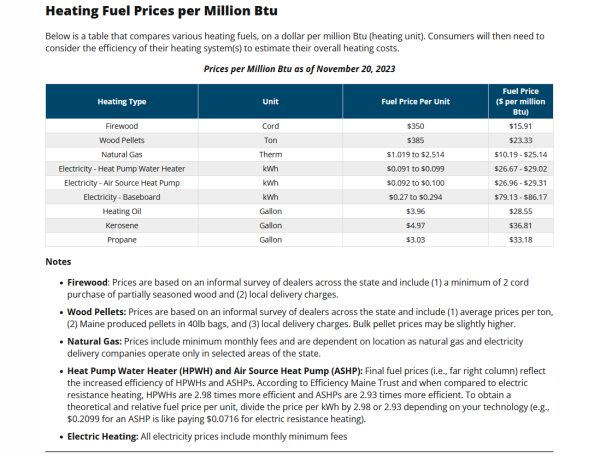Burning wood pellets cost more than burning firewood. But not a lot more, honestly. Remember our chart of heating fuel costs per million BTUs? Here it is again, with info from November of this year:
Those are Maine prices, but they’re high in my experience. It might be because I live in the poor-people-land part of Maine. God knows what people with whales on their pants pay for things Downeast. They’ve usually got more money in their Ikea couch cushions than I have in my bank account, but that’s their problem. Or mine, I forget which.
Pellets are flirting with $300 a ton nowadays, even for the ho-hum brands, but you’d have to be burning some artisanal free-range pellets to spend $385 a ton. Same thing with firewood. I haven’t bought any lately, but you’d have to swallow the dealer’s buncombe about just how “seasoned” their firewood is to pay $350 a cord. Green firewood you dry yourself costs much less, and no matter what it costs, you’ll be drying it yourself, remember?
But let’s go with these numbers. You’re buying kiln-dried firewood, and pellets from forests filled with trees on the endangered species list. What would it take to produce the 800,000,000 BTU WAG (wild-assed-guess) I made yesterday, depending on the fuel, at today’s prices? Lessee:
- Firewood: $12,728
- Wood Pellets: $18,664
- Heating Oil: $22,840
Rely on my experience in these matters (if you dare): The firewood number is way off, but then again, it’s not. Firewood isn’t that expensive to buy, but then again, a firewood furnace is a woefully inefficient thing compared to something like an oil burner in good working order. Lots and lots of BTUs go up the chimney. It’s the nature of the steel beast. And the amount of BTUs you get out of the woodpile varies greatly, from log to log. But the number is wrong in two directions, so maybe it balances out.
As far as wood pellets go, I actually know how much it cost me to get 800,000,000 BTUs. We paid a total of around $12,500 for 50 tons of the stuff. It averaged around $250 a ton. No one selling it that cheaply this year, though, but you can still buy perfectly usable pellets for $300 a ton, with free delivery and no tax (heating fuel isn’t taxed in Maine). So using today’s prices, wood pellets would cost $15,000 for 8 million BTUs-worth.
The other costs to consider are what the heating plants cost to buy. The firewood furnace only cost us about a grand. The pellet stove cost about two grand. An oil burner would have cost me $10,000 to install ten years ago, and probably more now. Yikes. And that’s just the cover charge to get into the crude oil dance, remember?
So buying a pellet stove and installing it ourselves and fixing it ourselves cost about half of what it would cost to buy, have installed, maintain, and buy fuel for an oil burner.
But our pellet stove cost even less than what I listed. Here’s how to save even more on your pellet stove: Buy a domain name with “wood pellet” in it. It costs $12 a year. Load WordPress on a hosting server. WordPress is free, and hosting is cheap. Get a free theme for your website. Write 12 search-engine-optimized reviews of pellet stoves and pellet brands and publish them on the website. Slap Google Adsense on the website. Whenever any of about 300 people (over 10 years) leave a comment, whether to ask a question or simply complain about something, answer it politely. Collect enough money from Google to pay for the website and the pellet stove, and make some inroads on paying for all the pellets, too. Easy.
But I’m not satisfied. I’m never satisfied, am I? I got tired of shoveling firewood into the furnace, and only sleeping 3 hours at a stretch in the winter. I got tired of humping 8 tons of pellets into my basement every year, and then humping them up the stairs 40 pounds at a time. I got tired of vacuuming out the pellet stove. I began to dream. Not only that, I began to dream BIG. I dreamed of a dial on the wall, and if you turned it, the temperature in the house simply changed. I dreamed of a heat pump.
[To be continued]




7 Responses
Man! You make me glad I live in Arkansas. When I moved here from Louisiana (back before the earth’s crust cooled) I felt I was moving within sight of the aurora borealis. Reading the “Cottage” I feel downright toasty.
Thinking about you cooling your cojones in Arkansas makes me happy to be living in San Antonio.
Hi Mike- Merry Christmas to you and everyone else there in San Antonio. Are they all as pleasant as you? Never been.
Hi Emil- Thanks for reading and commenting. Merry Christmas!
I was looking for weather data and the city with extensive data near you is Augusta, ME. I’m guessing that their weather might be slightly different being 20 miles closer to the ocean, but probably not by much. So a heat pump starts making a little more sense, given that in a statistically-average year (right) you don’t see extensive periods of time below -10°F. You might tap that extreme a couple of times but typically you’re not going to spend weeks below zero.
This is a good thing since even the more modern air-source heat pumps don’t really gain much efficiency over straight electrical resistance heating at temperatures below about -15°F to -20°F depending on design. I’m guessing that ground-sourced heat pumps in your area (granite underneath you, mostly) is ‘way too capital-intensive. For the majority of winter in your area air-sourced should be pretty good, and you can always use the pellet stove and wood furnace as back-ups if it gets REALLY cold.
As an added benefit you can run the heat pump as an A/C, given that summers there are generally a bit more humid than they are hot. Knock the edge off the humidity in the house and you don’t have to cool the air much to feel a lot more comfortable.
Whee, can’t wait to see how this turned out.
Hi Blackwing- That’s all right on the money. Of course It’ll take a week or so of my off-topic meandering and fart jokes to explain it, but that’s it.
Merry Christmas to you and your family from everyone here at the Cottage.
I would not trust the “given that in a statistically-average year (right) you don’t see extensive periods of time below -10°F. You might tap that extreme a couple of times but typically you’re not going to spend weeks below zero.”
Currently and for the past several years we have had much less snow than what used to be typical. The problem being is that we have more humidity in winter and still have the very cold temperatures. Typically we would have close to 4 months with the probability of hitting -20F. Now we are having +20F and without the snow cover it feels much colder. My point is that moisture makes a big difference in how the body reacts to temperature. My second thought is that as you and Mrs. Sippican age you will feel the cold more. Do you plan to live out your lives in this house?